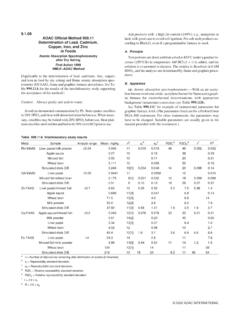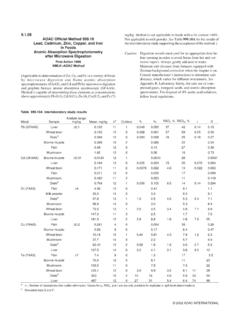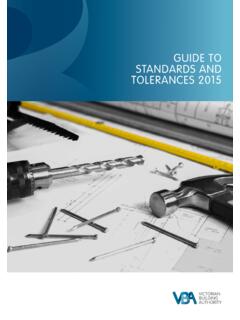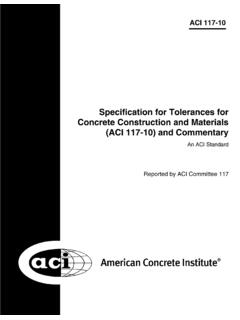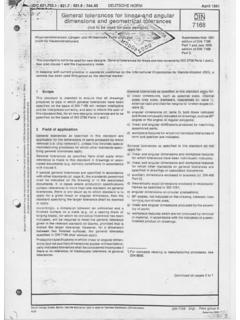Transcription of General tolerances - 21food.cn
1 BRITISH STANDARDBS EN22768-2:1993 ISO 2768-2:1989 General tolerances Part 2: Geometrical tolerances for features without individual tolerance indicationsThe European Standard EN 22768-2:1993 has the status of aBritish StandardUDC Copy: London South Bank University, London South Bank University, Wed Mar 15 03:46:41 GMT 2006, Uncontrolled Copy, (c) BSIBSEN22768-2:1993 This British Standard, having been prepared under the direction of the Machine, Engineers and Hand Tools Standards Policy Committee, was published under the authority of the Standards Board and comes into effect on15 July 1993 BSI 03-1999 The following BSI references relate to the work on this standard:Committee reference MTE/24 Draft for comment 87/78364 DCISBN 0 580 21934 8 Cooperating organizationsThe European Committee for Standardization (CEN), under whose supervision this European Standard was prepared, comprises the national standards organizations of the following countries.
2 AustriaOesterreichisches NormungsinstitutBelgiumInstitut belge de normalisationDenmarkDansk StandardiseringsraadFinlandSuomen Standardisoimisliito, fran aise de normalisationGermanyDeutsches Institut f r Normung Organization for StandardizationIcelandTechnological Institute of IcelandIrelandNational Standards Authority of IrelandItalyEnte Nazionale Italiano di UnificazioneLuxembourgInspection du Travail et des MinesNetherlandsNederlands Normalisatie-instituutNorwayNorges StandardiseringsforbundPortugalInstituto Portugu s da QualidadeSpainAsociaci n Espa ola de Normalizaci n y Certificaci nSwedenStandardiseringskommissionen i SverigeSwitzerlandAssociation suisse de normalisationUnited KingdomBritish Standards InstitutionAmendments issued since publicationAmd. Copy: London South Bank University, London South Bank University, Wed Mar 15 03:46:41 GMT 2006, Uncontrolled Copy, (c) BSIBSEN22768-2:1993 BSI 03-1999iContentsPageCooperating organizationsInside front coverNational forewordiiForeword2 Introduction31 Scope32 General33 Normative references34 Definitions35 General geometrical tolerances36 Indications on drawings57 Rejection5 Annex A (informative) Concepts behind General tolerancing ofgeometrical characteristics6 Annex B (informative) Further information7 Annex ZA (normative) Normative references to international publicationswith their relevant European publications10 Figure Principle of independency.
3 Maximum permissibledeviations on the same feature7 Figure Examples of General tolerances on circularity8 Figure Parallelism deviation equal to the numerical value of thesize tolerance8 Figure Parallelism deviation equal to the numerical value of the straightness tolerance8 Figure Examples of General tolerances on symmetry8 Figure Example of General tolerances on a drawing9 Table 1 General tolerances on straightness and flatness4 Table 2 General tolerances on perpendicularity4 Table 3 General tolerances on symmetry4 Table 4 General tolerances on circular run-out5 National annex NA (informative) Committees responsibleInside back coverLicensed Copy: London South Bank University, London South Bank University, Wed Mar 15 03:46:41 GMT 2006, Uncontrolled Copy, (c) BSIBSEN22768-2:1993ii BSI 03-1999 National forewordThis British Standard has been prepared under the direction of the Machine, Engineers and Hand Tools Standards Policy Committee and is the English language version of EN22768-2:1993 General tolerances Part 2: Geometrical tolerances for features without individual tolerance indications, published by the European Committee for Standardization (CEN).
4 It is identicalwithISO2768-2:1989 published by the International Organization for Standardization (ISO).A British Standard does not purport to include all the necessary provisions of a contract. Users of British Standards are responsible for their correct with a British Standard does not of itself confer immunity from legal of pagesThis document comprises a front cover, an inside front cover, pages i and ii, theEN title page, pages 2 to 10, an inside back cover and a back standard has been updated (see copyright date) and may have had amendments incorporated. This will be indicated in the amendment table on theinside front Copy: London South Bank University, London South Bank University, Wed Mar 15 03:46:41 GMT 2006, Uncontrolled Copy, (c) BSIEUROPEAN STANDARD NORME EUROP ENNE EUROP ISCHE NORMEN 22768-2 April 1993 UDC : Machine components, geometrical tolerances , machining tolerances , dimensional deviations, specificationsEnglish versionGeneral tolerances Part 2: Geometrical tolerances for features without individual tolerance indications(ISO 2768-2:1989)Tol rances g n rales Partie 2: Tol rances g om triques pour l ments non affect s de tol rances individuelles(ISO 2768-2:1989)Allgemeintoleranzen Teil 2: Toleranzen f r Form und Lage ohne einzelne Toleranzeintragung(ISO 2768-2:1989)This European Standard was approved by CEN on 1993-04-15.
5 CEN membersare bound to comply with the CEN/CENELEC Internal Regulations whichstipulate the conditions for giving this European Standard the status of anational standard without any lists and bibliographical references concerning such nationalstandards may be obtained on application to the Central Secretariat or to anyCEN European Standard exists in three official versions (English, French,German). A version in any other language made by translation under theresponsibility of a CEN member into its own language and notified to theCentral Secretariat has the same status as the official members are the national standards bodies of Austria, Belgium,Denmark, Finland, France, Germany, Greece, Iceland, Ireland, Italy,Luxembourg, Netherlands, Norway, Portugal, Spain, Sweden, Switzerland andUnited Committee for StandardizationComit Europ en de NormalisationEurop isches Komitee f r NormungCentral Secretariat: rue de Stassart 36, B-1050 Brussels 1993 Copyright reserved to CEN membersRef.
6 No. EN 22768-2:1993 ELicensed Copy: London South Bank University, London South Bank University, Wed Mar 15 03:46:41 GMT 2006, Uncontrolled Copy, (c) BSIEN22768-2:19932 BSI 03-1999 ForewordIn 1991, the InternationalStandard ISO 2768-2:1989 General tolerances Part 2: Geometrical tolerances for features without individual tolerance indications was submitted to the CEN Primary Questionnaire the positive result of the CEN/CS proposal, ISO 2768-2:1989 was submitted to the formal result of the Formal Vote was European Standard shall be given the status of a national standard, either by publication of an identical text or by endorsement, at the latest by October1993, and conflicting national standards shall be withdrawn at the latest by accordance with the CEN/CENELEC Internal Regulations, the following countries are bound to implement this European Standard: Austria, Belgium, Denmark, Finland, France, Germany, Greece, Iceland, Ireland, Italy, Luxembourg, Netherlands, Norway, Portugal, Spain, Sweden, Switzerland, United European references to international publications are given in annex ZA (normative).
7 Licensed Copy: London South Bank University, London South Bank University, Wed Mar 15 03:46:41 GMT 2006, Uncontrolled Copy, (c) BSIEN22768-2:1993 BSI 03-19993 IntroductionAll features on component parts always have a size and a geometrical shape. For the deviation of size and for the deviations of the geometrical characteristics (form, orientation and location) the function of the part requires limitations which, when exceeded, impair this tolerancing on the drawing should be complete to ensure that the elements of size and geometry of all features are controlled, nothing shall be implied or left to judgement in the workshop or in the inspection use of General tolerances for size and geometry simplifies the task of ensuring that this prerequisite is ScopeThis part of ISO 2768 is intended to simplify drawing indications and specifies General geometrical tolerances to control those features on the drawing which have no respective individual indication.
8 It specifies General geometrical tolerances in three tolerance part of ISO 2768 mainly applies to features which are produced by removal of material. Its application to features manufactured by other processes is possible; however, special examination is required to ascertain whether the customary workshop accuracy lies within the General geometrical tolerances specified in this part GeneralWhen selecting the tolerance class, the respective customary workshop accuracy has to be taken into consideration. If smaller geometrical tolerances are required or larger geometrical tolerances are permissible and more economical for any individual feature, such tolerances should be indicated directly in accordance with ISO 1101 (see clause ). General geometrical tolerances in accordance with this part of ISO 2768 apply when drawings or associated specifications refer to this part of ISO2768 in accordance with clause 6.
9 They apply to features which do not have respective individual geometrical tolerance geometrical tolerances apply to all geometrical tolerance characteristics, excluding cylindricity, profile of any line, profile of any surface, angularity, coaxiality, positional tolerances and total any event, General geometrical tolerances in accordance with this part of ISO 2768 should be used when the fundamental tolerancing principle in accordance with ISO 8015 is used and indicated on the drawing (see clause ).3 Normative referencesThe following standards contain provisions which, through reference in this text, constitute provisions of this part of ISO 2768. At the time of publication, the editions indicated were valid. All standards are subject to revision, and parties to agreements based on this part of ISO 2768 are encouraged to investigate the possibility of applying the most recent editions of the standards indicated below.
10 Members of IEC and ISO maintain registers of currently valid International 1101:1983, Technical drawings Geometrical tolerancing Tolerancing of form, orientation, location and run-out Generalities, definitions, symbols, indications on 2768-1:1989, General tolerances Part 1: tolerances for linear and angular dimensions without individual tolerance 5459:1981, Technical drawings Geometrical tolerancing Datums and datum-systems for geometrical 8015:1985, Technical drawings Fundamental tolerancing DefinitionsFor the purposes of this part of ISO2768, the definitions for geometrical tolerances given in ISO1101 and ISO5459 General geometrical tolerances (see also clause ) tolerances for single Straightness and flatnessThe General tolerances on straightness and flatness are given in Table 1. When a tolerance is selected from Table 1, it shall be based, in the case of straightness, on the length of the corresponding line and, in the case of flatness, on the longer lateral length of the surface, or the diameter of the circular Copy: London South Bank University, London South Bank University, Wed Mar 15 03:46:41 GMT 2006, Uncontrolled Copy, (c) BSIEN22768-2:19934 BSI 03-1999 Table 1 General tolerances on straightness and CircularityThe General tolerance on circularity is equal to the numerical value of the diameter tolerance , but in no case shall it be greater than the respective tolerance value for circular radial run-out given in Table 4 (seeexamples in clause ).
